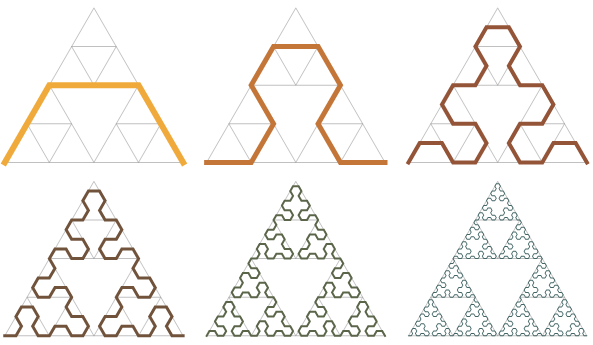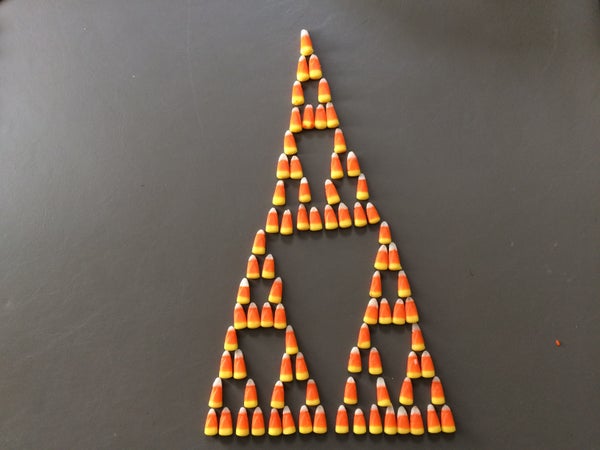This article was published in Scientific American’s former blog network and reflects the views of the author, not necessarily those of Scientific American
Every year around this time I think of the Sierpinski triangle.
I dare you to watch that video and then eat some candy corn without singing “Candy corn colonels, candy corn colonels.”
On supporting science journalism
If you're enjoying this article, consider supporting our award-winning journalism by subscribing. By purchasing a subscription you are helping to ensure the future of impactful stories about the discoveries and ideas shaping our world today.
The Sierpinski triangle, like many fractals, can be built either “up” or “down.” To build it “down,” start with a solid triangle and then remove the middle quarter, remove the middle quarter of each remaining triangle, and so on. The object you have after infinitely many iterations is the Sierpinski triangle.
To build it “up,” candy corn is recommended: make a little candy corn triangle, then make a triangle of triangles, then make a triangle of those larger triangles. It gets bigger and more complicated with each iteration. It doesn’t make much sense to say that the Sierpinski triangle is what you get when you repeat this process infinitely many times because that would just spill out everywhere, but you can imagine that at each stage you take a picture and squeeze it down so it takes up the same amount of space as it did before.
In addition to those two straightforward ways of building the Sierpinski triangle, there are many other processes that all seem to magically converge on the Sierpinski triangle. You can play something called the “chaos game” and watch random starting points transform into the Sierpinski triangle based on a few simple rules. You can color in all the odd numbers in Pascal’s triangle, which was discovered by several different cultures, including Chinese and Indian, centuries before Pascal was even born. You can draw a single black square on a big grid and then proceed to follow the cellular automaton called rule 90.
But I want to think about another way to do it called Sierpinski’s arrowhead curve. To make this pretty shape, you start with a jagged line. At each step, you replace each straight line segment with another jagged line according to a couple of rules that you can see emerging in this illustration.

After a few iterations, the Sierpinski triangle peeks through in this curve. Credit: Robert Dickau Wikimedia (CC BY-SA 3.0)
I like the arrowhead curve because it shows that not only can you approach the Sierpinski triangle by whittling down two-dimensional shapes in the removing triangles version of the space, but you can also create it by building up a one-dimensional object. That makes some intuitive sense: the Sierpinski triangle is not quite one-dimensional and not quite two-dimensional. It’s really more like 1.585-dimensional. (For more on what a fractional dimension means, check out my post on another object with fractional dimension, the Menger sponge.) If you can make the same object by thinning out something two-dimensional or fattening up something one-dimensional, it makes sense that in some sense its dimension lies between the two numbers.
Wacław Sierpiński’s name is on some pretty good mathematical objects. In addition to this fabulous triangle, there’s an analogous shape called the Sierpinski tetrahedron that lives in three-dimensional space. Then there’s the Sierpinski carpet, a two-dimensional version of the Menger sponge I wrote about a couple months ago. Finally, there's the space simply known as the Sierpinski space, which just has two points in it. Math grad student Tai-Danae Bradley recently wrote a post about why those two measley points are interesting on her blog, Math3ma.
Those other Sierpinski-honoring spaces are all perfectly respectable, but the triangle is the one that tastes the most like Halloween.
.png?w=283)
Credit: Evelyn Lamb
Read about more of my favorite spaces:
The Cantor Set Fat Cantor Sets The Topologist’s Sine Curve Cantor's Leaky Tent The Infinite Earring The Line with Two Origins The House with Two Rooms The Fano Plane The Torus The Three-Torus The Möbius Strip The Long Line Space-Filling Curves The Wallis Sieve Two Tori Glued along a Slit The Empty Set The Menger Sponge The Connected Sum of Four Hopf Links Borromean rings
